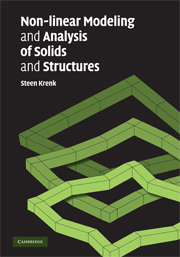Book contents
8 - Numerical solution techniques
Published online by Cambridge University Press: 05 June 2012
Summary
The solution of non-linear problems relies heavily on numerical methods. Only few non-linear problems allow direct solution, and most often an iterative strategy must be used. A simple example of such an iterative strategy is the Newton–Raphson method described in Section 1.2. In its standard form it consists of a series of prescribed load increments combined with an iterative solution of the equilibrium equations for the corresponding displacement increments. This strategy has a number of disadvantages. In the full Newton–Raphson method each step in the iterative solution requires solution of a linearized set of equations. This may involve a very high computational effort, and therefore modified versions, in which the equations are not reformulated in each step, can be an alternative. The modified Newton–Raphson method has slower convergence, and this may offset some of the gain from the simplified solution of the equations. In addition to concerns about the numerical efficiency, the Newton–Raphson method also encounters problems in passing limit and bifurcation points.
In the Newton–Raphson method the load increment is specified at the beginning of the load step and kept constant during equilibrium iterations. This leads to lack of efficiency and possibly complications when the stiffness changes rapidly, and in particular around load limit points where the sign of the load increment changes. Several techniques have been developed to deal with this problem. Here two types of techniques will be described.
Information
- Type
- Chapter
- Information
- Non-linear Modeling and Analysis of Solids and Structures , pp. 256 - 289Publisher: Cambridge University PressPrint publication year: 2009
